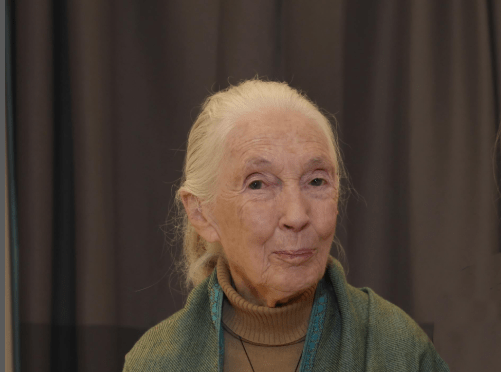Jane Goodall established not only a reputation but also a lasting impact that cut across boundaries over the course of the last seven decades, becoming a particularly clear voice in the fields of science, conservation, and humanitarianism. Despite being small by celebrity standards, her $5 million net worth reflects her lifelong dedication to education, ecosystems, and animals. Instead of accumulating fortune to show off, she invested it—often discreetly—in worthwhile projects that would outlast her.

Goodall’s journey from a young dreamer in London to a world-renowned primatologist played out like a well-paced novel during a period when scientific areas were overwhelmingly dominated by men. At the age of ten, she expressed her want to live in Africa among wild animals after being inspired by tales like Tarzan. It would have been dismissed as a childish fantasy by most grownups. However, Margaret, her mother, decided to help her, starting a career that would eventually go against some of the most inflexible scientific presumptions.
Jane Goodall: Life, Career, and Net Worth
| Category | Detail |
|---|---|
| Full Name | Dame Jane Morris Goodall, DBE |
| Date of Birth | April 3, 1934 |
| Date of Death | October 1, 2025 (aged 91) |
| Nationality | British |
| Known For | Groundbreaking chimpanzee research, conservation, and advocacy |
| Primary Profession | Primatologist, Anthropologist, Ethologist |
| Key Organization | Jane Goodall Institute (founded in 1977) |
| Estimated Net Worth | $5 million at time of death |
| Education Background | Studied under Louis Leakey; PhD from Cambridge University |
| Honors and Awards | Templeton Prize, Presidential Medal of Freedom, UN Messenger of Peace |
| Major Works | In the Shadow of Man, The Book of Hope, The Chimpanzees of Gombe |
| Media & Appearances | Jane’s Journey, Reasons for Hope, The Wild Thornberrys |
| Reference | Celebrity Net Worth |
Under the guidance of famed anthropologist Louis Leakey, Jane arrived at Tanzania’s Gombe Stream National Park around 1960. Her uncommon observational sensitivity, rather than her extensive list of academic credentials, was what set her research apart. She gave chimpanzees names such David Greybeard, Flo, and Goliath rather than numbers, unlike her contemporaries. She let their personalities shine through and carefully recorded their actions rather than analyzing them objectively.
She made one of the first discoveries that rocked academia: chimps producing and utilizing tools. It forced a reconsideration of what it meant to be “human,” drastically reducing the line between humans and other creatures. She was transformed from a researcher to a scientific trailblazer by that discovery alone.
Her study gained widespread attention during the 1960s and 1970s, especially because to National Geographic’s exquisitely drawn reports and television specials. The 1965 television program Miss Goodall and the Wild Chimpanzees offered viewers an honest but loving glimpse into the complexity of chimpanzee cultures. She created a storytelling model for contemporary environmental media by telling the tale of living in the forest rather than only presenting data.
Goodall’s transition from scientist to full-time campaigner in the 1980s is what makes her legacy so groundbreaking. She established the Jane Goodall Institute in 1977 after realizing that chimpanzees were in danger due to poaching, deforestation, and human conflict. This organization evolved into a worldwide leader in conservation and community-based ecological education in addition to being a center for research. Initiatives such as Roots and Shoots, which were started in 1991, have enabled young people in more than 100 nations to take concrete steps to protect the environment and animals. Since then, the project has significantly raised awareness of biodiversity and local sustainability practices.
Her financial resources, which frequently came from royalties, working on documentaries, and giving speeches all over the world, were managed with dedication and discipline. Auditories were packed with speaking engagements, and publications such as Hope for Animals and Their World and In the Shadow of Man were regularly praised and sold well. Even in her senior years, she exhibited self-control by traveling with very little luggage and choosing cheap lodging.
Despite being credited as a founding inspiration by popular people such as Greta Thunberg, Emma Watson, and Leonardo DiCaprio, Goodall herself rarely capitalized on her celebrity position. She made an appearance on television as a guide rather than a guest, sharing knowledge based on experience rather than appearance. As Oprah Winfrey once said, Jane was “the voice of reason when everything else felt too loud.” Scientists, students, and activists throughout the world have echoed this view.
Her influence went beyond the scientific community. She expanded ecological storytelling’s audience by working with environmental journalists and filmmakers. Her eagerness to interact with younger audiences on their terms is demonstrated by her humorous and very varied presence in The Wild Thornberrys, when she narrated herself in an animated children’s program.
As travel was halted by the pandemic, Goodall modified her message. She co-authored The Book of Hope, which became a powerfully relevant book during a period of widespread uncertainty, gave lectures via Zoom, and took part in virtual summits. “Hope is a strategy, not a sentiment,” she stressed, gently but firmly. That perspective proved especially helpful to young environmentalists who were depressed about the state of the climate.
Her estimated $5 million net worth at the time of her death in 2025 never fully captured the extent of her impact. Rather, it exposed a lady who used books, documentaries, lectures, and grassroots movements to create a flourishing ecosystem of change. She launched educational initiatives, empowered local communities, and funded research while remaining financially independent. She was an inspiration not only to scientists but also to nonprofit executives, educators, and business owners because of her ability to strike a balance between practicality and morality.
Her work had reached every continent by the time she died in California at the age of ninety-one. Her name was inscribed on the soil of transformation, from youth campaigns in Southeast Asia to forestry initiatives in East Africa. Her comments are especially poignant even after her passing, as though they were told to future generations.
On October 1, 2025, it was confirmed that she had died of natural causes. As a traveling messenger of hope, she had been giving speeches around the United States at the time. Her final message—that her life was never about ends but rather about fresh beginnings driven by knowledge and compassion—was emphasized in the notice released by the Jane Goodall Institute.
